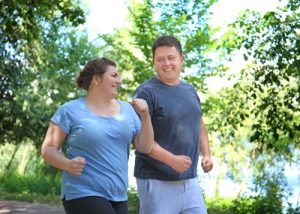Back to Patient Portal
For those out there that aren’t big fans of exercise (and the sceptics that struggle to believe that anybody actually enjoys exercising) then this blog is likely going to make your day. If you don’t like or can’t handle rigorous exercise, struggle to find time to get to the gym on a regular basis or just find the time in your busy schedule to work out in general, then walking may be the answer to your fitness prayers.
 It’s easy to forget sometimes that walking is actually an aerobic activity. The majority of us take it for granted. It’s such a natural, low-impact movement that we don’t realise that when doing so we are actually forcing our body to take in more oxygen than when we are sedentary, providing the same benefits as running.
It’s easy to forget sometimes that walking is actually an aerobic activity. The majority of us take it for granted. It’s such a natural, low-impact movement that we don’t realise that when doing so we are actually forcing our body to take in more oxygen than when we are sedentary, providing the same benefits as running.
So we’ve established walking is actually exercise. The weekly exercise guidelines are 150 minutes of moderate-intensity aerobic exercise. Breaking it down, 30 minutes a day 5 days a week… break that down even further to 3 intervals of 10 minutes throughout a day. When you think of that in terms of walking, making time for exercise seems much more achievable doesn’t it? That could simply involve getting off the bus or train a stop or two earlier than you usually do, or taking the stairs instead of a lift, on your lunch break going for a walk around the block rather than sitting at your desk.
So let’s take a closer look at some of the reasons why you should consider increasing your steps (you’re getting your 10,000 steps a day in, right?) and upping the pace when you do.
Stronger Bones & Increased Muscle Strength
Aging isn’t pretty; unfortunately as we age our bones become weaker and our muscles lose their strength. But all is not lost, as walking regularly can build and tone muscle mass (particularly the muscles in your legs and back) and can also strengthen your bones.
Healthy Heart, Healthy You
As walking is an aerobic activity it increases heart rate and blood pressure, resulting in greater efficiency of the heart. In fact, some studies have demonstrated that walking can reduce your risk of developing heart disease by up to 31%! Speaking of getting the blood pumping, walking can also improve your circulation too.
Mood-Boosting Power
Exercising releases endorphins, triggering a positive feeling in your body (similar to morphine believe it or not!). More and more research is demonstrating that moderate-intensity exercises, such as walking, have been shown to prevent depression. Walking outside has the added benefits of exposure to sunlight and fresh air, all adding to a mood-boosting effect.
Walking After Bariatric Surgery
Following your bariatric surgery, you have a new lifestyle to adhere to in the form of your new diet and introducing exercise into your daily routine. If you haven’t exercised much in the past, walking is a great way to get into exercising.
Some tips for starting out and making the most of walking as your form of exercise:
- Start short – start yourself off with a short distance, whether that be around the block or to the end of a road and back. Then slowly increase your distance as you build your confidence.
- Time is of the essence – not so hot with measuring distance? Try timing yourself. Start with a 10-minute walk, and as you get used to that add an extra five minutes each time until eventually, you’ve built yourself up to 30 minutes.
- Pick up the pace – once you’ve incorporated walking into your everyday routine, challenge yourself a little further by picking up the pace. Test yourself over distances, so, for example, see how quickly you can walk your normal route and try to beat it.
- Uphill struggle – or if you’re not keen on picking up the pace, try changing the course. Walking at an incline offers a new challenge, requiring more effort and really working those muscles. Try introducing a hill climb once or twice a week once you’re confident with walking in general.


0 Comments